S.C. Green's Blog, page 6
October 10, 2018
Writer’s block really does exist. Here’s how to beat it.
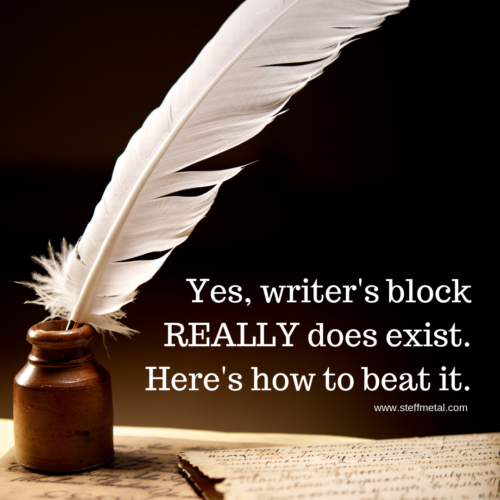
“The Writer is an infantryman. He knows that progress is measured in yards of dirt extracted from the enemy one day, one hour, one minute at a time and paid for in blood. The artist wears combat boots. He looks in the mirror and sees GI Joe. Remember, the Muse favors working stiffs. She hates prima donnas.” –Steven Pressfield.
Steven Pressfield wrote this amazing book called Gates of Fire. It’s a fictionalised account of the famous battle of Thermopylae. If you enjoyed 300 but wanted a few less monolithic elephants, then you’ll love this book.
He also wrote this other amazing book called the War of Art. In it, he compares the work of an artist to that of a soldier, or sometimes to a general, and shows how artists must (and can) overcome resistance in order to flourish. It’s a tough read if you’re a tender soul – Pressfield pulls no punches at what he sees as lazy habits and excuses. It’s one of the best books about the creative process I’ve ever read.
He has a lot to say about writer’s block, which he calls the Resistance. Pressfield doesn’t regard writer’s block as a passive force – a wall blocking your way – but rather it’s this active, malevolent other that must be thwarted, or surrender is inevitable.
Even though many writers like to claim writer’s block doesn’t exist, Pressfield’s description felt true to me, so I decided to investigate.
The history of writer’s block
Being the person I am, if I want to dig into a subject, I first look at how it’s been dealt with throughout history. I thought writer’s block was a ubiquitous term understood since the time humans first put pen to papyrus. How wrong I was.
It turns out the terminology “writer’s block” was coined by psychoanalyst Edmund Bergler in 1947. However, the idea of it does go back much further, with many historians and commentators noting periods of stagnation during the lifetimes of prolific writers like Leo Tolstoy, Ernest Hemingway, Katherine Mansfield, and Herman Melville.
“You don’t know what it is,” groaned Gustave Flaubert to a friend, “to stay a whole day with your head in your hands, trying to squeeze your unfortunate brain so as to find a word.”
Even now, there are suggestions writer’s block might have its roots in science. The writer and neurologist Alice W. Flaherty explains that under stress, the human mind is controlled by the limbic system of instinctual cues (your fight-or-flight responses). This system often shuts off creative processes in order to fulfill its function of getting you out of danger.
For all the years that writers have suffered thus, others have jumped up to recommend solutions, from changing surroundings, free writing, or going into therapy, to Agatha Christie’s wonderful suggestion of “eating apples in the bath.” Like all advice, some of it will work for you, most of it won’t, but you won’t know until you try it all.
I’m going to add a few more suggestions into the mix. But first, do you even need to worry about writer’s block at all? Isn’t it the mark of all great writers to toil in this creative cesspit?
Newsflash: you can’t afford writer’s block
There’s no denying that for many writers, feeling ‘blocked’ is a real thing. Denying this is pointless. The key question is not if writer’s block exists, but whether you want or need to change it.
If you’re a hobbyist and you’re okay with putting down your project for months at a time while waiting for the block to pass, then you can claim writer’s block to your heart’s content.
But if you’re aiming to be a professional writer, then you’ve got to find methods to work through your blocks. Writing is work, and like all work sometimes you’ve got to do it when you don’t want to. You never hear about a nurse with “nurse’s block”, or a plumber with “plumber’s block” (haha!). Why do we deserve to claim this special term to describe the fact we’d rather watch Netflix in our pajamas?
You have to be tough with yourself because the world does not stand still and wait for you to be ready to write. Readers will go and pick up other books and form unhealthy obsessions with other, non-blocked writers and those writers will buy mansions and fancy cars and all the boats in the world and all the boats that have been made in the past or will be made in the future and then how will you sail around the Canary Islands on your literary dollars?
You don’t get paid if you don’t work. In order to work, you’ve got to get the words down. Up to a certain point, it doesn’t matter which words they are. Of course you can’t just write “oook oook oook” repeatedly and expect the Pulitzer Prize. What I mean is, as a creative you’re usually digging into a number of different projects at once. If one project isn’t working, switch to another. You’ve got to keep getting words down because that’s the only way the mortgage gets paid.
Before you throw up your arms and claim writer’s block, ask yourself the following questions:
Are you waiting for inspiration?
“You can’t wait for inspiration. You have to go after it with a club.” Jack London said that, and he’s awesome, so I think you should listen to him.
If you wait for inspiration, you’re going to wait a long time. For some people, that’s totally cool. But if you want to make a living at this, you have to learn to write even when you’re not inspired.
So much of writing isn’t about the genius ideas and inspired zingers. It’s about slotting the puzzle pieces of a story together. The inspiration is the dart in the middle of the bullseye, but the work is adding in the dart-board, the grimy wall in a backwater pub, the crew of miscreants you’re playing darts with, and the body slumped over the pool table.
Sit down. Work. Make with the clickety-clacks. Inspiration doesn’t make a writer. Perseverance does.
Are you being a lazy-arse?
Or lazy-ass, if you’re American.
Here’s a thing – we often think that in order to go and do stuff, we need to be motivated. The action follows the desire. Most of the time, it’s the other way around.
My ability to get shit done on any given day is all about how much I force my lazy-arse mind to do what it doesn’t want to do. That first act of defiance is the loudest and boldest and scariest. It gets much easier after that.
I know that exercising daily makes me happy. I know it makes my days more productive. I know that 11AM is the ideal time for me to get this done, and that I can do my routines in 20-45 mins and listen to some killer tunes.
Even knowing all that, sometimes I don’t care. It gets to 11AM. My alarm rings, and I keep working, or reading, or faffing around on Facebook. I don’t exercise.
Sometimes I have to drag myself to my weights by bargaining with myself. “You only have to do one circuit, and then you can stop.” Anything to make me pick up that Olympic bar. After I’ve done one set, I always, always do the other two. Because I’ve hit the zone where I know it’s good for me and I want it. The desire follows the action.
Find out how to trick your brain. Bribe yourself. Create a reward system. Put on a timer. Try these other hacks. Don’t let laziness be your excuse.
Is there a problem with your story?
It’s absolutely possible to write yourself into a corner, or to have a need to get a character from point A to point B but to draw a blank on how.
For me, when this happens – and it happens less and less these days as I improve my craft – it usually means that a character isn’t acting like themselves, or I’ve written a scene that doesn’t have any conflict.
That kind of block to me means the story is broken.
Instead of staring at the blank page and trying to puzzle out how to move forward, I’ve got to dig deeper. I can’t place a band-aid on a bullet wound. I’ve got to go back in time and stop the bullet from leaving the gun.
This is the point where I’ll often explain the situation to my husband, or to a writer friend. The simple act of explaining the story will often alert me to the issue. Otherwise, a few follow-up questions usually get to the crux of the problem.
If I can’t or don’t want to talk out the story with someone else, I’ll ruminate on the issue for a few days. If possible I’ll skip ahead in the book to a section I can write, so I can keep working. While I do that, I use my thinking time (aka, my shower time) to allow my mind to wander.
Are you not ready to write this book?
It could be that you’re trying to tackle a topic that’s emotionally difficult for you, and writing about it means remembering or dealing with that issue. It could be that you’ve had an idea that’s big and wonderful and important, but you don’t feel as though you’re developed enough in your craft to do it justice. Maybe you’ve got a new baby in the house and your cat just died and you ran out of coffee and it’s just not a good time right now. Or it could be that there’s some consequence for you writing a book – for example, if you’re whistleblowing or writing a memoir about your family that you know they’ll read.
If you’re not ready, it’s okay to acknowledge that, and to figure out what steps to take to make you ready, and to take them. Or, to put that project away and work on something that brings you joy instead of fear and anger and pain.
Are you burned out?
This one happens to professional writers and it’s gutting. You’re trucking along doing all the things and then WHAM. You. Just. Can’t.
If this is you, or you suspect this might soon be you, take a motherfucking break. This has nearly been me so many times. It had been me once for definite but probably more times I didn’t acknowledge.
Quit some stuff. Everyone has stuff they can quit. Saying no feels amazing. Do it more often.
Nothing cures burnout except turning the fire back on. To do that, you’re gonna need some fuel. Eat well. Get exercise. Go outside and smell the fucking flowers. Call your mom. Read a good book. Remember that the world is more than words on a page. Stoke that fire.
Did someone say your story is crap?
It could be, but who cares?
Sometimes, people are dicks. There are people who take a perverse pleasure in tearing down enthusiasm and making others feel small and sabotaging creativity. They usually end up being the people we tell all our most brilliant ideas and spill all our secrets. That’s how the universe works.
If other people are stopping you writing, either physically (by throwing your computer out a window) or mentally, then you gotta get rid of them, either physically (by throwing… I’ll let you fill in the rest) or mentally.
Are you afraid of something?
“Resistance is experienced as fear; the degree of fear equates to the strength of Resistance. Therefore the more fear we feel about a specific enterprise, the more certain we can be that that enterprise is important to us and to the growth of our soul. That’s why we feel so much Resistance. If it meant nothing to us, there’d be no Resistance.”
That’s another wee pearl of wisdom from our man, Steven Pressfield.
At its core, all writer’s block may boil down to fear. Fear of failure, of rejection, of putting something out into the world and having it help up for ridicule. Or fear of success – of becoming someone we don’t like, or having our privacy impacted or our world shattered.
I wrote a long, meaty article about conquering your fears as a writer. Give it a squizz. It may just help.
And celebrate every small victory against that fear. Relish the defeat of Resistance. That’s how you grow as a human.
If you want to banish your writer’s block, consider:
You don’t have to work through a book/project in a linear fashion.
It’s okay to put a project down and pick it up when the timing’s better. Just make sure you’re moving forward with something.
You broke your story. You can fix it, but you’ll need to go back and figure out how you broke it first.
Identify what it is you’re afraid of. Can you find techniques to minimize and deal with that fear?
Eliminate distractions and create a regular habit to force yourself to write through that initial discomfort.
Talk about your ideas with a supportive friend or family member. They might help reinvigorate you.
Are you making excuses? Are you wallowing? Are you using the words “I’m blocked” when you really mean, “I’m lazy.”
Write some words. That’s the only way to get over writer’s block. They might be terrible words, but eventually, you’ll write something worth sharing. If you don’t start, you never will.
More brilliant writing about writer’s block
How Steven Pressfield helped me to drop the term ‘Writer’s Block’ by writer and veteran Matthew Webb.
Author Jeff Goins (he’s pretty famous in writing productivity circles) on how to overcome writer’s block: 14 tricks that work.
The ever-hilarious Chuck Wendig has 25 ways to defeat the dreaded writer’s block. They are all brilliant. He’s also got another one on what writers block REALLY is.
There’s no such thing as writer’s block, by Randy Cassingham, mainly looking at the excuses we tell ourselves about our writing.
More about the science of writer’s block.
Don’t want to miss my essays on writing, creativity, or rocking life as a working artist?
Sign up for the Creative Rebel newsletter to have each weekly article delivered to your inbox.
October 9, 2018
Post scriptum: geeky wedding, imminent adventures, and the return of my chickens
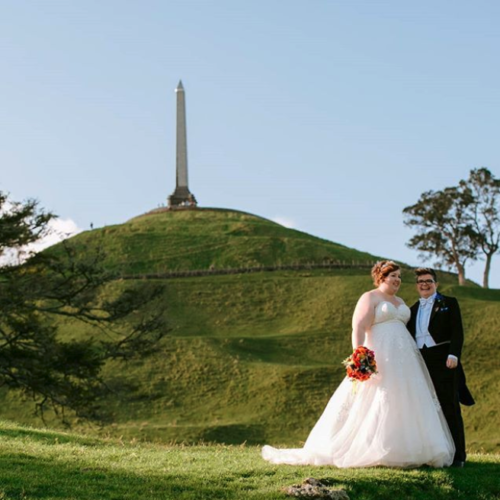
Last weekend I had the honour of performing a geeky wedding ceremony for my friend Jamie and their partner Anna. This is likely the last wedding I’ll ever perform as a NZ marriage celebrant, and I couldn’t have asked for a more loving and fun couple to go out on!
My friend Amy from Northwic also made Jamie’s jacket, and she’s now creating a range of tailored clothing for men and also for women/gender non-binery folk, so hit her up if you need something custom and amazing.
This is post-scriptum, which is my semi-regular blog post about some of the stuff I’m reading and listening to and doing at the moment.
Listening: A friend introduced me to Heilung and I’ve been addicted ever since. If you like Wardruna, give ’em a listen.
Reading: Right now, I’m all about the gothics – this collected edition of Wuthering Heights/Jane Eyre, and Consort of Fire, the fourth book in Eva Chase’s Witch’s Consorts series I wrote about here.
Watching: Old episodes of Have I Got News For You on Youtube.
On the farm: It’s sheep shearing week this week. Also, we planted 65 trees for a shelter belt and did a lot of clean-up. I’m currently going through our ‘junk room’ and putting stuff we don’t use up for sale, and we’re just trying to get our lives in order and finish little jobs around the house in preparation for summer.
Loving: We just bought our plane tickets for Europe and I am mega-excited. We got a crazy-good special, which means more money to spend on black t-shirts. \m/ making chocolate fondant for desserts at home and feeling like a million dollars \m/ my silly cats. Boudica has decided she loves people now and so we’ve got three of them piled on the bed every night and two sleep on my feet most of the day. \m/ OUR CHICKENS ARE LAYING IN THEIR COOP AGAIN OMG. You have no idea how nice it is to have fresh eggs again. No more freeloading chickens. \m/ Opeth at Wacken. \m/ Readers messaging me to say how much they appreciated my books, and especially the POC characters and the way they were portrayed. Obviously, I’m writing outside my experience for those characters, so it means a LOT when I hear from readers with that experience that I got it right. \m/ Online shopping at all my favourite gothy stores for a big reader giveaway (details soon!).
That’s what I’ve been loving lately, what about you?
October 1, 2018
New goodies for you: A collection of halloween-themed reverse harem shorts, and a reverse harem cookbook!
I’ve been busy working on the final book in the Briarwood Witches series, and it’s definitely making me super sad to finish up with these characters. Everyone’s been enjoying the prequel story, The Summer Court, so much, I thought I’d give you a little bit of bonus material and a glimpse into everyday life in Maeve’s harem.
Check out Halloween Between the Sheets and Hungry for More for some fun treats.
Halloween Between The Sheets
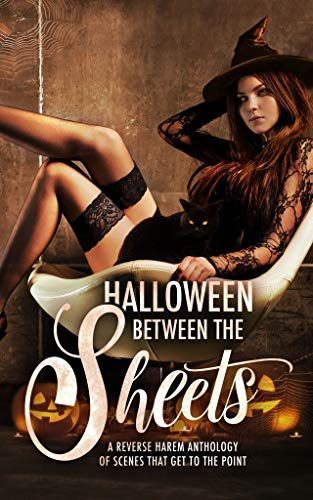
It’s Halloween, but this collection of hot and steamy scenes is all treat and no trick. Put the candy away and get sticky within the pages of this compilation of all new exclusive scenes from twenty of your favorite Reverse Harem authors.
Alongside some of my favourite reverse harem authors (Joely Sue Burkhart, KT Strange, Skye MacKinnon, etc), I’ve contributed a sexy Halloween short story about Maeve and the guys. Right now the only way to read this story is to get this collection. You can order Halloween Between The Sheets now for $2.99 in Kindle or free in Kindle Unlimited.
WARNING: This short story contains MAJOR spoilers for the Briarwood Witches series. It comes out only a few days before The Castle of Spirit and Sorrow, which is the final Briarwood Witches book. If you don’t want details of that book spoiled, then DON’T read this story or even LOOK at it until after Spirit and Sorrow comes out.
Hungry for More: A Harem of Recipes
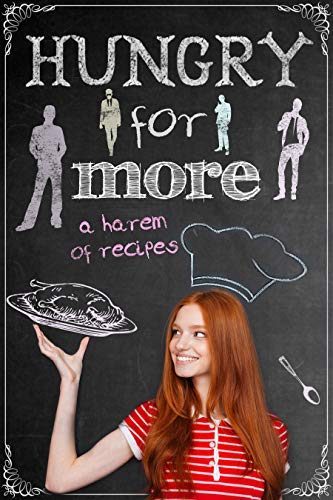
Are you longing to know how to make the delicious food you read about?
Look no further! Grab your whisk, put on your apron, and tell your harem to get chopping. From spicy to sweet, you’ll find a recipe for every occasion in this drool-worthy cookbook brought to you by 21 bestselling reverse harem authors
Get ready to try out 60+ recipes featured in some of your favourite reverse harem stories. All proceeds go to charity!
When Skye suggested the idea of creating a reverse harem cookbook, I HAD to jump on it. I’ve contributed three recipes you’ll be familiar with if you’ve read the Briarwood Witches series, including Rowan’s scones, Arthur’s Viking mead, and Flynn’s Double Chocolate Irish Whiskey Cake. Grab Hungry for More: A Harem of Recipes for $0.99 on all these awesome retailers. All proceeds are going to support Action Against Hunger, an international humanitarian organisation working to fight the causes of hunger across the globe,
September 27, 2018
Wellington, I’ll be in you 8-11 November for LitCrawl!
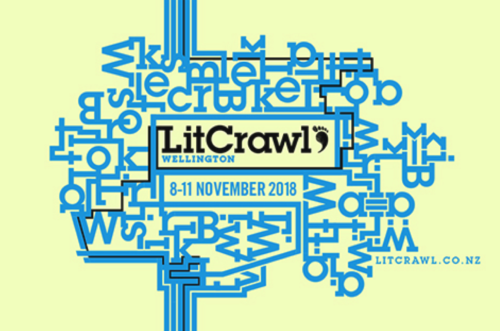
LitCrawl is the premier writers festival in Wellington. In true kiwi style, the main event involves a literary crawl on November 10th through various venues and bars around the city, getting exposed to new ideas and amazing writers. There’s also a LitCrawl Extended series of events between 8-11 November.
I’m honoured to be involved in three events:
Crip the Lit: The Great Debate, where two teams of disability and literary luminaries debate the moot that there’s no such thing as a disabled writer. We are all just writers.
Killed Off – A conversation between me, Annaleese Jochems, and Elizabeth Knox about how and why we kill off characters (I am SO excited about this one, as both my panel-mates are authors I greatly admire).
A self-publishing workshop where I spill all my secrets. Come armed with a ton of questions! (Te Auaha, Cinema, Sunday 2-3PM).
Entry to events is by donation (suggested $5), except for the workshops – you can buy tickets here).
Other awesome sounding events I’d like to attend are the Badass Bitches of Wellington Walking Tour, the Dead Ladies Show, a salon-style event that originated in Berlin and celebrates awesome women in history, Bringing Down the Man about feminist activism, Of Mermaids and Mermen – a talk from writer Megan Dunn about researching her book on real-life merpeople, and Emily Writes + (girl)friends, about the enduring power of female friendships. I’ll also be at the afterparty because I will have just done two events back-to-back and I will need booze!
I’m going to be in Wellington for four days, catching up with friends and fellow writers and getting my fill of my favourite NZ city. If there’s something I’ve absolutely got to do while I’m there, hit me up!
How to decide which story idea to write next
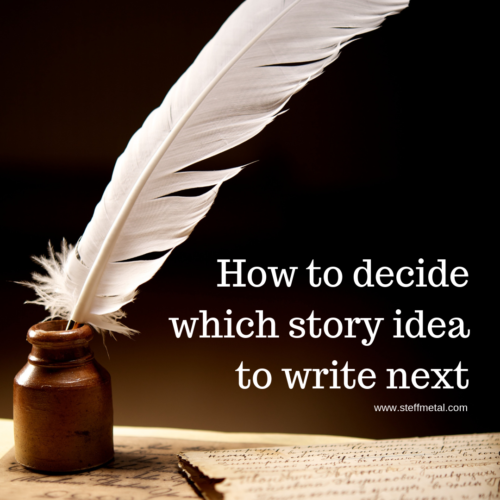
I just got back from attending the National Writers Forum, a writer’s conference put on by the New Zealand Society of Authors. It was an enjoyable conference with some big names in the NZ lit scene in attendance – many of whom I’ve admired for a long time.
Coming from the world of genre writing and self-publishing, where everything is focused on the global market and on pleasing readers first and foremost, it was interesting to see how the other half lived. This is the world of fellowships and publishing grants, of 500-book print runs being bestsellers, of indigenous stories and the importance of a national literature identity, of the main goal of seeing New Zealand stories on the page.
There are so many different paths to take to get your stories heard and build a career as a writer. I loved seeing the possibilities for smaller projects and a local focus. I agree that it’s important to have this local scene alongside the global writers with our global stories – in fact, many writers happily straddle both worlds.
While I sat in on a panel featuring local publishers, I started thinking about how, as writers (or any creative) we can be pulled in different directions. There’s no controlling the muse – she reaches out and grabs us by the goolies at the worst possible times, usually to distract us from our path with completely ridiculous ideas that were never going to be commercially viable.
Even when you have a clearly-defined path to follow, the Muse can strike, offering you tantalizing hints at other worlds and options. On my Steffanie Holmes pen name I’m winding down the final book in a series, and for the next series I’m struggling to choose between three ideas – all good options, but only one can come next. I have other project ideas too, all tugging me in different directions.
How to choose?
Pitch your idea to yourself as if you’re the publisher
As writers, our Muse often pulls us toward the idea that offers the best creative challenge. But before dedicating months of our time to this creative endeavour, we should step into the publisher’s shoes and consider it from another angle.
At the panel, a publisher said, “when we consider a book, we’re looking at it in an entirely different way from a writer. Even if we love the book, we have to convince our sales team and executives and accountants that it’s worth the investment.”
So what? Who even cares what accountants think about your book?
You should.
That is, if you want it to have the best chance at commercial success.
Even if you intend to self-publish, you should take that accountant into consideration. Because that accountant will help you get lots and lots of money in your wallet (theoretically – nothing is guaranteed in this business).
Pretend you are your publisher. (If you’re self-publishing, you don’t have to pretend). Sit down with yourself (you can even dress up if you want to, or pour yourself a drink) and throw down your ideas like a wicked rap battle. If you like to take notes, you may want to draw up a piece of paper with different ideas in boxes, and pro/con lists next to them.
(I come from the Rory Gilmore school of decisions by list-making.)
Pitch your ideas as a writer. Note down what excites you creatively about them.
Now, put on your publishing hat. You are no longer a writer at the mercy of a fickle muse. You are a hard-nosed business person who has an accountant to placate.
Look at each idea. Consider it from a commercial standpoint:
1. Ask how this idea fits in with your currently established audience? If your pen name writes urban fantasy, will your contemporary women’s fiction really be the best fit?
2. Are you the right author or publisher for this book? Do you have the skills or expertise needed to do the idea justice?
3. Think about the potential marketing plan for this book. Can you see where it fits on Amazon or on the shelf in a bookshop – if you can slot it into a category, it’ll be easier for readers to find and devour.
4. Look for similar books and try to gauge how well they’ve performed. Is there a market for this type of work? Does that market need more?
5. Are other publishers (not you) acquiring these types of books? Have a look at their websites and the #MSWL hashtag to see what people are looking for.
6. Can you foresee how the project will be marketed? Will there be a series or spinoffs? Is it a good candidate for crowdfunding?
7. Are there current trends, news pieces, or cultural discourse that fit the themes of one of your projects?
Where are you at as a creative?
Of course, these commercial concerns aren’t the only considerations when choosing a new writing project. You should also weigh up your own creative mind to figure out if you’re more drawn to one particular idea. You might consider:
Where you’re at in your career and what you want your next project to achieve.
The topics/themes or characters feel especially relevant to you right now.
What you feel creatively able to tackle right now. (Kristen Kieffer of Well Storied calls this your ‘creative season.’ Do you want the sure, stable thing, or are you ready to tackle that big, scary project?)
The stories you want to tell or want to be known for telling.
The stories that require the least amount of effort for the greatest reward. (I know this sounds like a cop-out, but sometimes your situation requires it. If you’re a new parent and are surviving on 45 minutes sleep each day, you probably don’t want to be tackling that technical hard SF novel).
Which idea feels fresh and unique. Fresh and unique is always a risk, of course, but it can be the most rewarding work you do.
In an ideal world, your project will be the perfect intersection between what you’re excited about writing and what works commercially to bring you riches and fame.
Don’t want to miss my essays on writing, creativity, or rocking life as a working artist?
Sign up for the Creative Rebel newsletter to have each weekly article delivered to your inbox.
September 23, 2018
Women of Influence 2018, and my winning #suffrage125 essay
It’s been one of those crazy weeks where a million things have happened, so you get a double-whammy blog post with two updates. It really should be three, but I’m going to try and talk about the National Writers Forum in another post.
I wrote a thing!
To celebrate 125 years of women’s suffrage in New Zealand, The Big Idea ran an essay competition examining the role of women and equality in the arts. My essay, The Damned Mob Is Coming For Your Words, was the winner. You can read it on The Big Idea.
The #WOINZ awards
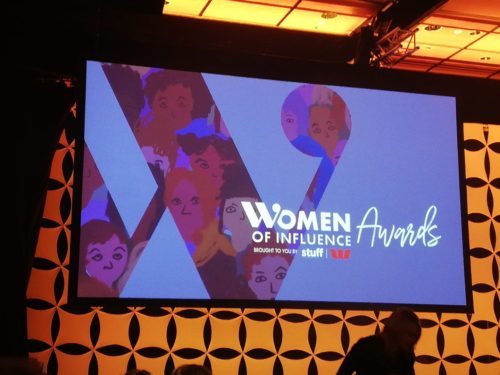
Back in July, I mentioned that I’d been announced as a finalist in the 2018 Women of Influence Awards. These awards recognise and celebrate women from all walks of life who make a positive difference in the lives of their fellow New Zealanders. It was a total surprise and an honour to be considered a member of that club!
On Tuesday – the eve of #suffrage125 celebrations in NZ – my BFF Andy and I attended the gala awards dinner, along with the associated forum where several speakers from across industry and politics discussed how far we’d come since we became the first country in the world to grant women the vote and how far we still have to go in order to reach true equality.
Much of the discussion was focused around issues in business and the workplace – representation of women on boards, the gender pay gap, quotas (for and against). It was very interesting to hear how different companies and industries were working to create policies and build cultures that fostered equality.
One thing we definitely agreed on – equality and diversity are better for everyone. This isn’t just about lifting women up at the expense of men or anyone else. It’s about doing better business, creating better products, and getting the brightest people into the roles where they can make a difference. I came away thinking about the role my books and my story can play in helping to achieve this.
After the forum we had a long, luxurious lunch, followed by getting our makeup done at the makeup counters. I actually never wear makeup, but since I’m doing a lot more public speaking / appearing in photographs I decided it was time to learn how to do my face. So with Andy’s help and the assistance of a wonderfully patient makeup artist (“So you just add your mascara—” “But HOW?”), I chose my first ever makeup purchases!
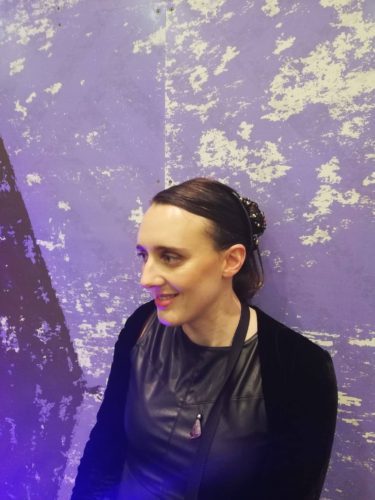
I got us a room for the night in a 2-star haunted hotel (seriously, it looks like something from Suspiria. I love it), and we dolled ourselves up and headed out to the event. I’ve never been anywhere so fancy. The food was AMAZING. The wine was free, we sat with a table of remarkable young women, including Ashleigh Smith from bullying nonprofit Sticks n’Stones, and sixteen-year-old Maddison McQueen-Davies who started a nonprofit to redistribute secondhand school shoes to kids who need them. Maddison won in her category.
The supreme winner was Jackie Clark from The Aunties, who do amazing work in the community for victims of domestic violence. Jackie was the right women to win and a true example of what the awards were all about.
I didn’t win, but that wasn’t even important. It was just an honour to be in the room with all that energy and all those change-makers. Also, there were five desserts and I ate them ALL.
Thank you NZ Women of Influence for inviting me along and celebrating the achievements of women and also for having five desserts.
September 12, 2018
Diversifying your income as a writer or creator
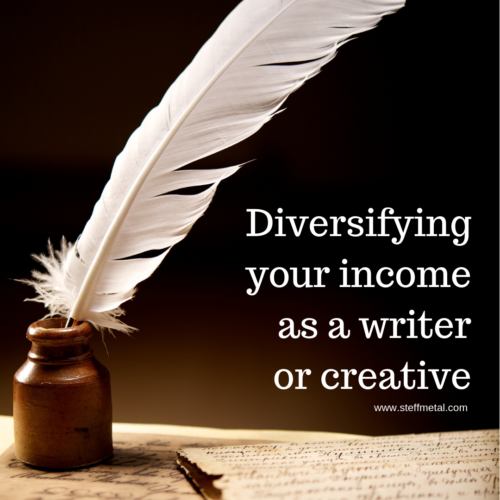
When I worked my day job, I’d get paid once monthly from a single source. The money was the same every month unless I got a pay rise (yay!) and arrived on the same day. If the company wanted to get rid of me, they would have to give me notice/pay out redundancy/go through a termination process. I’d have time to adjust, pivot, find new work.
Now that I’m a self-employed creative, things are different. I can’t rely on a single source of income anymore, because as a self-employed person I don’t have the same employment rights. If a client didn’t want to work with me anymore, they aren’t required to give any notice. I also don’t have the right to an audience. If readers aren’t into my latest book, they won’t buy it, and that impacts my ability to pay my mortgage.
The idea that your livelihood could be pulled from under you in an instant is pretty scary. For a creative person who relies on their ideas to pay the bills, the fear can hold you back from taking risks and accepting opportunities. Most creatives attempt to insulate themselves against this fear with diversification – the go-to strategy of successful investors for generations.
The fact that I have diverse income streams is the reason I was able to quit my job and do this awesome thing full time. Some streams pay more than others, but they all work together to make sure that if something bad happened I’d still be bringing in some money to help pay the bills.
I’ve been pursuing diverse income streams since I got my first job in the examinations department at my local university, and not always to my benefit. Here are some things I’ve learned along the way.
For beginners, diversification is the enemy of getting shit done.
I believe that if you’re building a sustainable career as a creative, then diversifying your income is absolutely essential. Not exceptions.
But.
If you’ve just starting out on the journey to becoming a full-time creative rebel, then you’re probably working on your craft in between a day job, a busy family life, and other commitments. You have very little time. You need to spend that time wisely, and the wisest use of that time is focusing on growing your core creative skills.
Also, no one knows who you are. You need an audience in order to build enough stable income to quit, and the best way to gain an audience is to give them as much of the same kind of content – the content they love – over a period of time.
During this stage, diversification is your enemy. You don’t have the time to do lots of things well. If you want to build momentum, you need to knuckle down and focus on the core of your creative business. Do one thing well. Become known for that. You can diversify later.
I’ve made this mistake SO MANY TIMES, which is part of the reason I’ve been writing this blog since 2009 but it wasn’t until nine years later when I was able to quit and do what I really wanted to do all along – writing books. I got distracted. I thought what I had to do was try lots of different things and wait for one of them to take off and then I’d have more time to write and grow as a writer. But the truth is, if I’d directed all my energy toward focusing on that one goal, I’d have got there a lot sooner.
Also, if you spread your focus across different projects that have different audiences, then you’re not being strategic. You’ll grow slower than if you just focused on doing one thing really well and getting it out there and finding your fans.
Smart diversification.
When should you diversify? I believe it should come after you have a big enough audience that the possibility of leaving your day job to do the thing is on the cards, but you’re feeling scared. If you’re like most creatives, you don’t go from nothing to superstardom – it’s a long, slow build and there’s a wobbly middle period where you’re making decent money but not quite enough money and it feels very precarious.
This is the time to start thinking about complementary ways to grow your business. Look for ways you can transform projects to grow your current audience, offer them something new, or get them to buy more at different price points. For example, if you’re a visual artist who sells originals, expanding into prints will enable you to grow your current audience as you’ll have more affordable products.
Can you build another income stream from your current portfolio of work? A visual artist could pitch mural ideas to large businesses and schools. A writer could use a backlist of successful books to offer ghostwriting services.
Instead of starting from scratch with a completely new audience, can you pivot an idea to work within your current business? I’ve had this idea for a cozy mystery series for a while, but it would involve starting a whole new pen name and building it from scratch. I’ve recently figured out a way to make the concept – with key changes – work under my current pen name so I’m not starting something completely new.
Don’t diversify just for the sake of it, and try not to land yourself with a huge long-term project when there might be a quicker way. Don’t lose sight of your end goal – making enough money so you can quit your job and feel safe that you don’t have all your income in one basket. This is where I say DON’T take on another pen name unless you’re 100% sure you need it and can keep up with it. Dividing your focus at this stage isn’t a great idea. Instead, maybe you could sell your current backlist in another format, or use it as a jumping-off point to secure some work teaching creative writing classes or ghostwriting.
Always consider passive diversification. For example, as an artist, if you can create an online store like Society6 where people can purchase your prints and work on other objects. Because these objects are print-on-demand, you don’t have to do anything except load designs and accept the checks. It’s a completely passive income stream you set up once and earn income on for the rest of your career. That income may only be a few cents a month to start with, but as your audience grows, so does the revenue.
For authors, thinking about additional formats – paperback and audio – is a good way to diversify. As is taking some or all of your backlist wide to build an audience in the other stores. Taking my backlist wide last year was one of the key reasons I felt safe quitting my job in Feb. If Amazon shut down my account tomorrow or tanked a release (please don’t do that!) I’d still have at least some income coming in.
Passive diversification is really the key to success as a creative. The more you can separate your income earned from your time, the safer and better off you’ll be.
Who do you want to be?
Always bring decisions about your creative business back to your creative direction. What do you want to be known for? What’s your ‘brand’ as a creative? How do you picture yourself in the market?
This means sometimes saying no to exciting opportunities and diversification ideas because they take you too far from what you want to be.
Don’t get so distracted by diversifying and new projects and opportunities that you lose track of your core principles, values, and joy as a creator.
Creating for Now, Soon and the Future.
Author Tim Leffel wrote a great article about writing for now, soon, and the future. When thinking about diversification, this is a really useful technique.
This is what I do. I have my now projects (New Steffanie Holmes books. They sell consistently and make up the core of my royalty income), my soon projects (new formats for Steffanie Holmes books, upcoming projects for S C Green, and Only Freaks Turn Things Into Bones, as well as random opportunities that come up like speaking gigs) and my future projects (some of which are top secret, but won’t bear fruit for another year or ten, if they even do).
Reassess and pull back.
A mistake a lot of creative people make – and I’ve been here many, many times before – is going nuts on the diversification and spreading yourself too thin. That’s why it’s really important to step back from your business and ask yourself if you’re happy. Have you moved too far away from your core goals as an artist?
I’ve done a lot of interesting things over the years. A webcomic! A sock business! Officiating weird weddings! Running a content agency! Writing for magazines! Running a business blog! I regret none of them, but I do regret the time they took away from my core focus as a writer – fiction. That’s why over the years I’ve dropped those projects as I’ve moved back toward what I really love.
At the end of 2017 I looked at my numbers and realised it was time to quit my day job. I made the conscious decision at that time to pull back on some of the non-writing things I’ve been doing – namely, working as an alternative wedding celebrant.
2017 was a stressful year for me. I had a day job, my book writing and freelance work that was basically another full-time job, working on the house, being a wife and a friend and a daughter, doing things I enjoyed that relieved stress – like hiking – that took me away from home for days at a time, and doing everything I could that earned money (weddings) even though they sapped energy and weren’t getting me closer to my goal.
I wanted 2018 to be different. I was away from home around 20 weekends last year, many of them at weddings. It was too much. I worked every night when I got home from work. I missed my husband even though we shared a house. He wasn’t super happy with things, either. We knew it was temporary so we could have the savings we needed so I could quit, but I also knew I hated it and I needed 2018 to be better. So I started saying no to weddings. And not feeling bad about it. I also made a rule for myself that I’d only be away 12 weekends in the year. That’s forced me to be pickier about opportunities and trips I take, and has been so much better on my stress levels. And my cats and husband are pretty happy about it, too.
I also paused my Patreon. I started the Patreon to create an additional income stream so that I was less reliant on Amazon. However, I believe because readers aren’t so familiar with ongoing crowdfunding, I had to sell them on the concept too much. The Patreon sucked time and energy, but it wasn’t growing. I decided to drop it and direct that energy to other avenues that ARE growing, such as promoting my books on the other retailers. I may pick it back up in the future if my audience grows and begs for that kind of bonus content, but for now, it’s not a sensible use of my time.
Right now, I have four income streams, and within those income streams is some diversification (books available across multiple retailers, for example). They are my two pen names, speaking/teaching about creative writing, and freelance writing for clients. I’m focusing on growing three income streams so I can eventually transition out of freelance writing and trading my time for money. I have a deadline for when I’d like to achieve that, but we’ll see how we go.
I’m not the only one talking about cutting back and refocusing. Joanna Penn of The Creative Penn recently wrote about how she was cutting back on some of her diverse income streams in order to get back to the core of what excited her about being an artist.
As a creative, have you diversified your offerings? Did you do what I did and diversify too soon? What ways can you move away from trading your time for money?
Don’t want to miss my essays on writing, creativity, or rocking life as a working artist?
Sign up for the Creative Rebel newsletter to have each weekly article delivered to your inbox.
Catch me Sept 21st at the National Writers Forum in Auckland on a panel with the fab Catherine Robinson and Lani Wendt Young talking about writing sex and romance!
September 11, 2018
Volcanofest 2018: Hiking the Tongariro Northern Circuit
Hiking is fun.
Except when it’s not.
Except when the weather is so shit you can’t see ten feet in front of you and your feet hurt and your whole body is sticky and you’re on fire and covered in army ants and you hate everyone and everything.
Some hikes are like that.
This one was not.
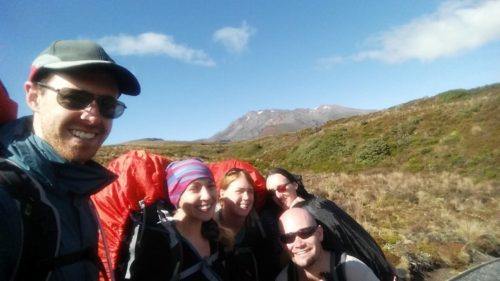
In March I hiked with some friends old and new around the Tongariro Northern Circuit, one of New Zealand’s nine Great Walk tracks. The hike normally takes four days to complete – we did it in three, but we cheated a little and missed the first day.
To complete the full track, you would start at the Whakapapa Visitor Centre and hike along the Taranaki Falls track to Mangatepopo hut. A few months previously I attempted the trek with another group of friends and we were turned back by the weather on the second day. Since some of us in the group had already hiked this day – and it’s definitely not the highlight – we decided to skip it to save on Annual Leave.
Day 1
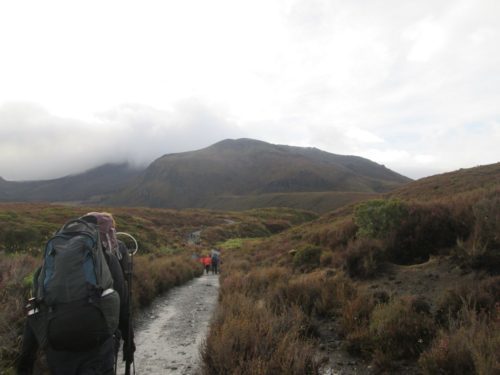
Instead, we took a shuttle bus to the Mangatepopo car park and hiked in 20 minutes to the hut. That plonked us in the middle of a misty, rocky valley with the giant cone of Ngauruhoe and the flatter form of Tongariro visible ahead.
From there, we walked around old lava flows and up the Devils Staircase (unnecessarily ominous I felt, but others agreed it was accurate) to the Mangatepopo Saddle, which was a snack break.
(Anyone who’s hiked with me knows I measure milestones by snacks, so this was a very important event.)

We then crossed the Red Crater. This is one of my favourite parts of the whole hike. Last time we hiked it was shrouded in the deepest, densest fog I’ve ever encountered. It messed with my vision to the point I had to slow down because I thought I was zigzagging everywhere. This time the weather was much nicer. It meant we could see the crater walls and the rock formations. It looked as though we were walking on the surface of Mars. Spectacular. We are so lucky to be able to experience something like this in New Zealand.

Chilling in the Red Crater

We had to climb up this to get out of the crater.

We reached the other side of the Red Crater – which was the point we turned back last time – and continued up the summit. Because the track is rocky, it’s marked out by poles (close enough together that I can JUST see the next one). The track follows the ridge of the crater and involves some serious scrambling over rock faces and a scoria-covered ridge. If you’re afraid of heights, this is not where you want to hang out. I loved every moment of it.
Then we had to go down. Yay!
(That was sarcasm. Down is not my friend).
We scrambled down a scree-covered slope, buoyed up by a spectacular view of the Emerald Lakes. These are old explosion pits that gleam in brilliant shades of blue and green (or grey and grey, if you are me). Their brilliant colouring is caused by minerals washed down from the thermal area of Red Crater.
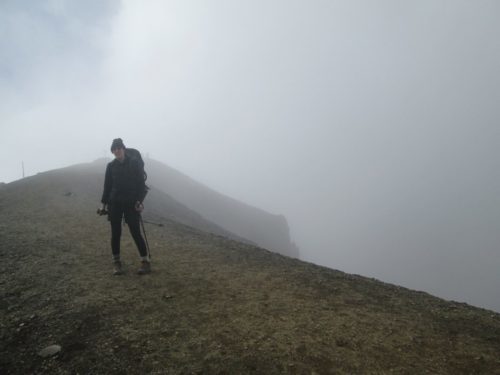
I am happy here because I am on Mars and we haven’t yet hit the scree.
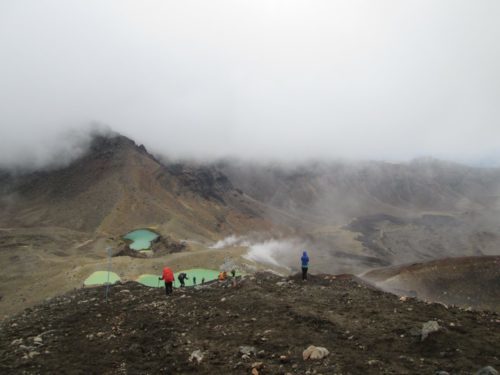
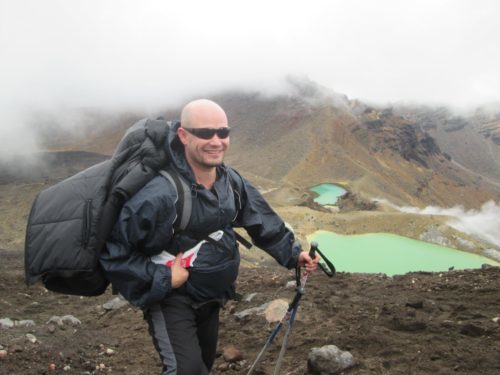
Scree is interesting – it’s just gravel piled up, and you’ve got to half walk, half skid down it, and try not to fill your boots up with it.
I failed.

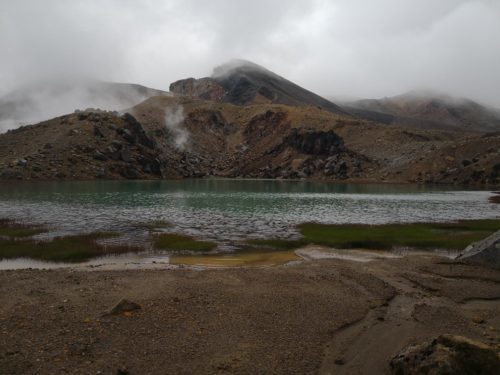
Emerald Lakes was another snack stop (success) and photo opp. Signs in this area alert us that we’re in an active volcano zone. We treated that with the gravitas and seriousness that was its due.
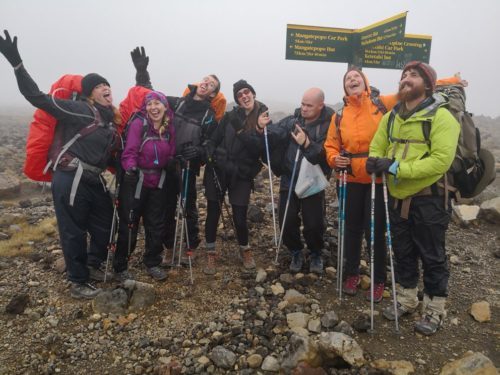
Gravitas.
More downhill over rocks and rocks and rocks. And some lava forms. But mostly rocks. Because I am sure-footed as a mountain goat, I had no trouble with this section WHATSOEVER.
That was also sarcasm.
As I learned on the Inca Trail, rocks are not my friends.

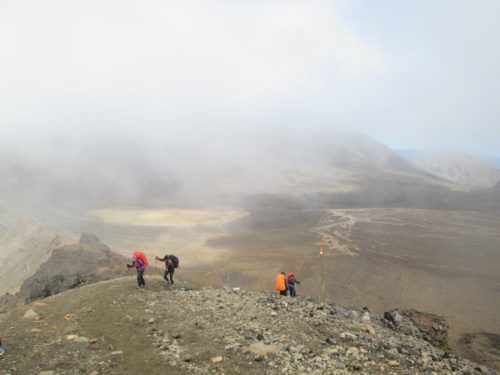
This bit went on forever. It was supposed to be 4km but it felt like 40. Finally, we could see Oturere Hut nestled on the eastern edge of the flows.
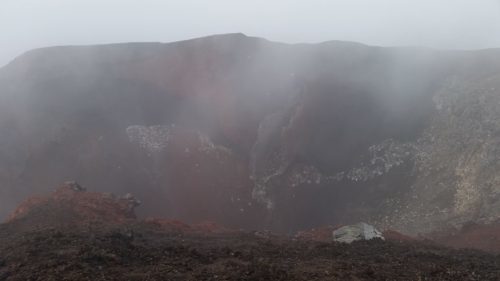
FOOD TIME. The hut was tiny, and because we have a very relaxed walking pace (ie, we are slow), the separate rooms had already filled up and the only beds left were in the main room with the stoves and tables. We staked out some beds and then commandeered a table outside. It was a little chilly but it meant we could all hang out.
We broke out the whisky, ate some delicious dinner (we’ve been getting these food packs from Go Native – I can recommend), played some games, and talked some shite. Then we went to bed where I slept for exactly 14 minutes and we had to get up again for day 2, aka the day of rocks to end all rocks.
Day 2
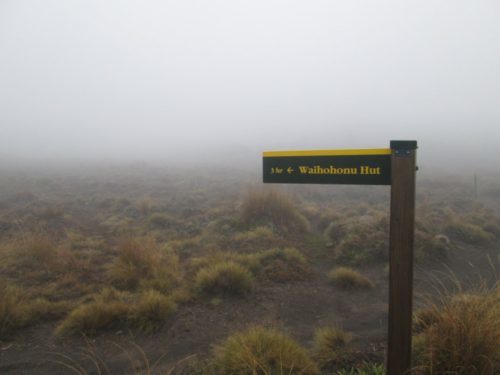
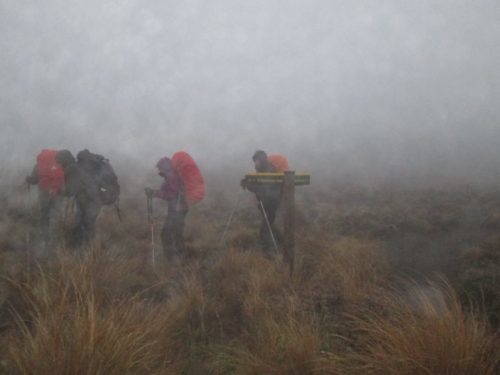
After leaving Oturere Hut the track undulates over a number of stream valleys and open gravel fields. The volcanic eruptions (some as recent as 2012) mean that there isn’t much vegetation. It’s just ROCKS. YAY.
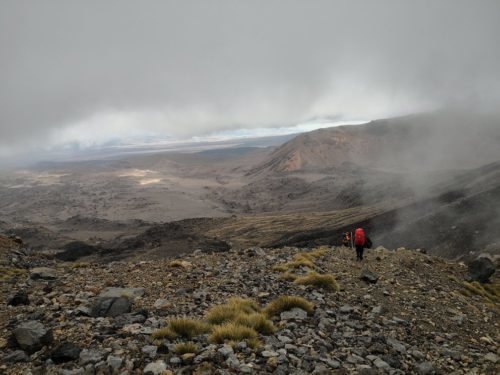
I love rocks.
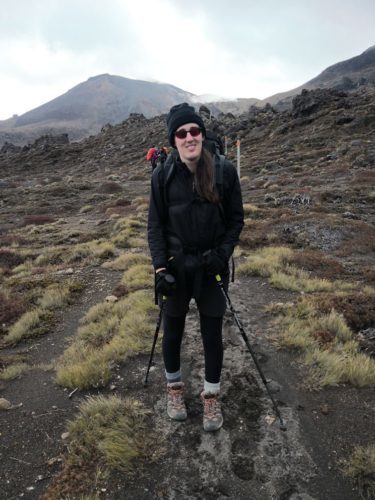
Such love.
One part I remember with particular clarity is clambering down a giant stream valley. My husband CDH calls the way I go over rocks, “The Stephanie Shuffle” – and I employed this extremely scientific technique here to hold everyone up while I inched my way down the slope. Miraculously, I didn’t fall over.
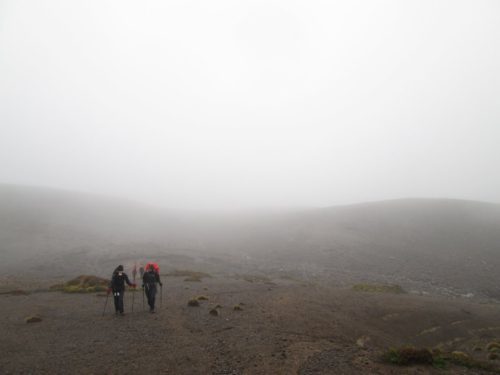

Halfway through this day, Sam pointed out that we technically didn’t have to wait until we reached the hut to enjoy our hiking whisky. What a revelation! Hiking after this point was much warmer and more pleasant. Whisky rations = low.

Whisky!
Finally, we caught sight of Waihohonu hut, and the path moved over even, packed earth and sand. I pronounced loudly how awesome it was that I survived the rocksplosion day without falling over once… and then promptly tripped over thin air and face-planted into the dirt.
Waihohonu Hut is like a palace. It’s enormous and there are plenty of tables for games and eating. It drizzled and colded outside (the technical term) while we played games and finished off the whisky.

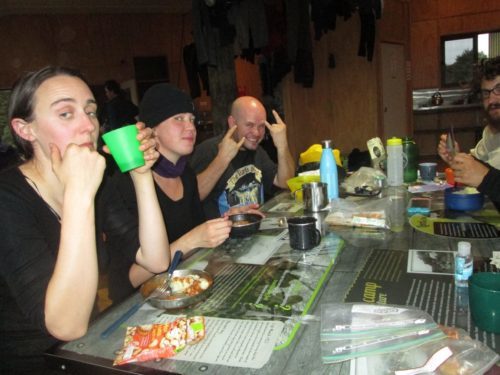
Day 3
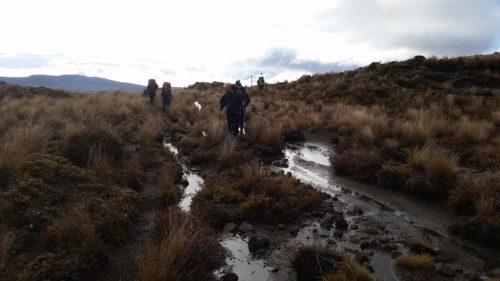
We woke up early. Technically, most of us never slept because we shared a cabin with a ridiculous snorer (ugh). We dragged our packs into the main room and commenced the morning ritual of faffing with gear, making porridge, and brewing tea. 17 hours later, we were ready to leave!
A few minutes from the hut is a historical hut we could explore. It had a separate (tiny and bare) room for women! It looked cold and like it would be full of crazy hillbillies.
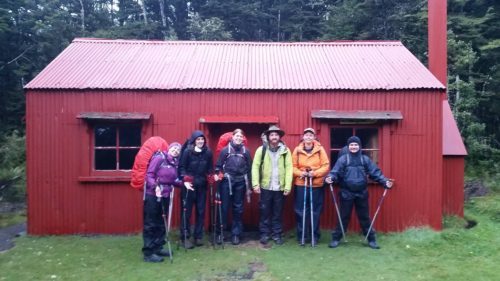
These are not the hillbillies you are looking for.

Mist cloaked the ridges as we clambered over rocks and down the Waihohonu stream on our climb to Tama Saddle. This day there was a lot of eerie mars landscapes and it was wonderful. The weather soon cleared and we had beautiful views of Ngauruhoe. We walked for five centuries and eventually, we hit road.
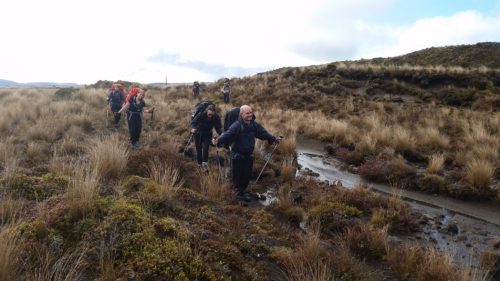
We drove back to Taupo and hit Pauly’s Diner for our celebratory feast. I ate two burgers and a slice of deep friend Mac&Cheese and I have no regrets. NONE.
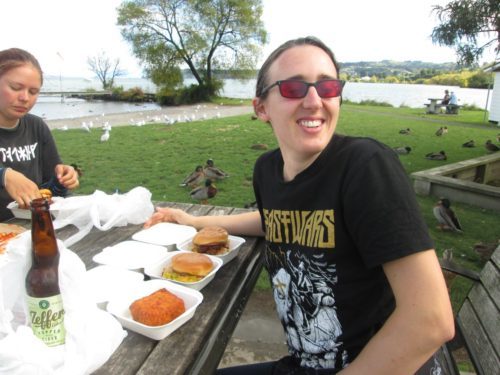
For my other hiking adventures, see my articles on The Inca Trail, The Routeburn track, and the Rakiura track.
All photos courtesy of Lee Janeway and Aaron Dick. Thanks Lee and Aaron!
August 29, 2018
How to finish the damn book
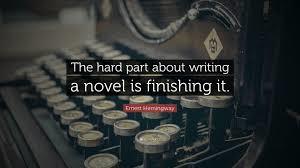
Just last week I wrote THE END on my 22nd book.
(Actually, if we’re being technical, I wrote ‘TO BE CONTINUED’ because the book ends on a whopper of a cliffhanger).
If you’d asked me ten years ago if I imagined myself in my 30s with more than 20 published books, I would have laughed long and heartily. My first novel – started during sixth form at high school, finished while at university, and edited into shape for two years after that – took around seven years from start to finish. My second book was four years.
I’ve discovered there’s truth in the adage that the more you write, the easier it gets. Not that writing is easy, but the words come faster now and I know what to do with them once they hit the page. Now I write an 80k word novel in two months.
If you look at that previous statement and think, “that’s not fair. I can’t even finish ONE book. Save some words for the rest of us,” then this article is for you. It outlines some of the techniques and mindset I use to get from “it was a dark and stormy night…” to “…and they all snuggled up in bed with pie.”
1. Set aside writing time.
You can’t finish the book if you don’t have time to write the book. We’re all busy, but if you try and claw time from your packed day, you’ll find it might be weeks or months before you have an uninterrupted stretch of writing time. You’ll probably spend most of that time re-reading what you’ve already written to remember your story.
Most books aren’t written in 8-hour uninterrupted creative binges (although that is definitely a thing). They’re written in 10/20/30 minute chunks around jobs, families, friends, charity work, and pole-dancing lessons. I believe all of us – no matter how busy we are – can find a 20-minute slot once a day to get some words done. If you can carve out that twenty minutes and use it to actually write, you’ll finish a book.
For the last year before I quit my day job, I would write during my commute, hunched over my laptop on the bus. It was uncomfortable and shitty, but I would tell myself that I could put the laptop away and read a book as soon as I got 1000 words. With two bus journeys a day, 2000 words quickly add up to a novel draft. (Note, these were early drafts only. I can’t edit on the bus like this).
2. Set yourself a word count goal
Writing a complete novel is a huge task, and it can feel overwhelming in the beginning. The classic rule of goal-setting is that when you feel overwhelmed, it’s because you don’t have achievable short-term goals. So set yourself some short-term goals. Most writers do this by setting a daily word-count.
To give you an idea, the average novel is 70-90,000 words. YA, category romance, and cosy mysteries are usually shorter, and fantasy/science fiction/historical tomes with lots of characters and world-building are usually significantly longer. Your first draft will likely end up shorter than your finished book, so aim for 50-60,000 words.
500 words a day (a single page of text on a word processor at 12pt font size), will net you a completed novel draft in a little over three months. If you can work even faster than that, you’ll get that draft done even sooner. I always recommend my students start at 250 words a day – it seems such a paltry amount as to not even make a dent in a book, but it will get you a complete draft in around seven months.
3. Try a timer.
If you have a twenty-minute writing slot, then you’ll probably already be using this technique informally, but even then I recommend setting a timer and sprinting.
This is called the pomodoro technique, and people around the world use it to improve their productivity. The standard way to do it is to sit down with a timer, set the timer for 25 minutes, work without stopping or getting distracted until the timer goes off, then mark off your ‘pom’ (that’s one 25-minute session) on a paper/spreadsheet, take a short break away from your computer (get a cup of coffee, do some lunges, chase that cat around, etc), then go back and do another. After 4 ‘poms’, take a longer break.
I used this technique to improve my speed. Now that I’m doing this all day every day, I don’t use it all the time. However, when I do I’m always more productive and focused. I do 20 minute poms because I find that better, followed by a short break where I absolutely MUST get out of my chair.
4. Outline that fucker.
There are two types of writers – plotters (who need everything planned in excruciating detail) and discovery writers (called pantsers because they write on the seat of their pants).
Even discovery writers like me benefit from an outline. When I start a new series I write a short outline of the idea and the character arc and what will happen in each book. For the five-book Briarwood series, it was about two pages, with most of the detail on book 1.
I discovered last year that actually I do outline. I just use my first draft as an outline. My first drafts are very rough, especially toward the end when they are half-finished sentences and 95% dialogue. It’s a way for me to quickly get down the structure of the book and figure out what happens where and how the characters will evolve within the story.
There are so many different outlining techniques. You need to find out what works for you. If you are stuck in your novel, then sitting down with an outline or beat sheet can help get you unstuck.
Try these:
Libbie Hawker, Take Off Your Pants (This is the outlining book I use).
K M Weiland, Outlining Your Novel .
Randy Ingermanson, How to Write a Novel Using The Snowflake Method .
Rachel Arron, 2k to 10k: Writing Faster, Writing Better, and Writing More of What You Love .
James Scott Bell, Write Your Novel From The Middle .
Ronald B Tobias, 20 Master Plots and How to Build Them .
Donald Maass, The Emotional Craft of Fiction .
5. Give yourself permission to write a crappy draft.
A problem writers in my classes face is the urge for perfectionism – these are people who spend all their writing time editing their first three chapters over and over and over. They don’t want to move on until their beginning is absolutely perfect.
This is something I did for years as a teen writer. The problem with it is that you won’t ever finish because nothing – especially not writing – is ever perfect. If you ever did finish the book, you may discover that you don’t even need those first three chapters after all. Imagine spending two years fine-tuning every word only to throw them all away.
Instead, focus on getting words on the page, no matter how crappy they are. You can’t edit a first draft until you have a first draft. My first, extremely rough draft is me spewing basic thoughts and unfinished sentences at a mile a minute. This draft is about 15,000-20,000 words for a full-length book. It is basically a long outline. I mark out chapters and create the scenes I want in the story, but those scenes mostly consist of some dialogue and action. The beginning few chapters get fleshed out but by the end, it’s a mess.
Once I have that structure in place, I go back and lay down the actual scenes. I fill in all the detail and finish all the sentences. I call this my first draft, although really it’s my second.
Once that draft is done, I re-read the book from beginning to end one last time, fixing any errors and filling in any final gaps, before sending it to my beta reader.
6. Write the scene that’s nagging at you.
Often when I’m writing, there will be a scene in my head I know has to be in the book, but I don’t know exactly how I’m going to get there. Instead of using my precious writing time figuring it out, I just write the scene and fill in the details later.
Remember, the goal of your 20 minutes of writing time is to get some words down. It doesn’t matter which words, in what order. They just need to be there when you’re finished.
I said earlier that I use my first draft as kind of a long outline. This also means that I’m allowed to skip ahead and write those nagging scenes that won’t leave me alone. You don’t have to write in a linear timeline. Words on the page are the important thing, not where they are in the story.
Plus, I find that if I skip ahead and write the scene, the problem of how to arrive there in the story solves itself.
7. Get an accountability partner
Having someone cheering you on and working toward the same goals can help keep you disciplined. Find a friend who also wants to write a book (they don’t have to be a writer, but it’s more fun if they are) and crack the whip for each other. Set yourself a daily or weekly target and check in with each other at a certain time to see how you get on.
Many of my writer friends do “sprints” together using a site called My Write Club. It’s like the timed writing we discussed above, except with other writers. You might be amazed at how writing with others improves your discipline.
8. Avoid not-writing
Once you’ve carved out your precious 20-minutes of writing time, don’t spend it doing non-writing things. There are oodles of activities writers indulge in that feel like work but actually aren’t, like research, social media, reading articles about writing (hello!), staring out the window, drawing maps or pictures of characters, or eating cheesecake.
Write, dammit!
9. Use flash cards and visuals
Some writers struggle with the linear nature of the book. They need to see the plot in a visual way. They want to be able to move things around easily. One way to do this is to use index cards and create a visual map of your plot and characters.
This is not a technique I use personally, but a lot of writers find it really useful. Margaret Dilloway outlines her index card technique on her blog. An amazing fantasy author named Holly Lisle also uses index cards.
10. Remind yourself why you’re doing this
I meet a lot of writers and wannabe writers who like the feeling of having written or talking about writing than the actual writing. I admit that sometimes the work feels like pulling teeth.
But it’s also fun. It’s special. Not everyone can do it. You get to create something from nothing but the wobbly stuff between your ears. You can reform the world and right the wrongs and convince everyone how awesome you are. Story and art move people and give hope and inspire change.
Chuck Wendig wrote a great essay (ALL HIS ESSAYS ARE GREAT OMG READ THEM NOW) on why writing is hard, but you should do it anyway. But don’t read it. Get to work.
Don’t want to miss my essays on writing, creativity, or rocking life as a working artist?
Sign up for the Creative Rebel newsletter to have each weekly article delivered to your inbox.
August 28, 2018
My latest reverse harem book, THE CASTLE OF WIND AND WHISPERS, available now!
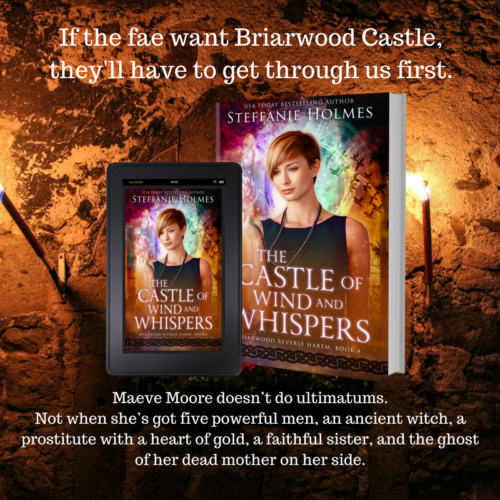
It’s release day! The happiest of all days for a writer! (Apart from ‘royalty payment day’ and ‘the day all the cats actually love you’ days).
You can now grab your copy of book 4 in my paranormal reverse harem series, The Castle of Wind and Whispers, for $3.99US or free in Kindle Unlimited.
Paperbacks are coming real soon, I promise!
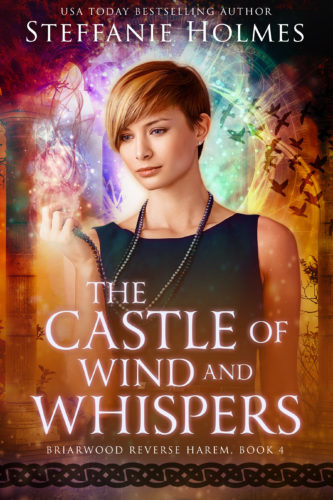
Now she’s returned from the dead, Maeve’s mother reveals the secret of how she defeated the fae twenty-one years ago. That secret will cost Maeve more than she could ever imagine.
Briarwood is no longer safe. The castle walls have been breached, and the coven’s enemies batter at their doors. The coven has two options left – surrender, or die.
Maeve Moore doesn’t do ultimatums, not when she’s got five powerful magic men, a prostitute with a heart of gold, a faithful sister, and the ghost of her dead mother on her side. Plus, her ancient castle still has a few tricks left to reveal.
If the fae want Briarwood, they’ll have to get through Maeve and her boys first.
The Castle of Wind and Whispers is the fourth in a brand new steamy reverse harem romance series by USA Today bestselling author Steffanie Holmes. This full-length book glitters with love, heartache, hope, grief, dark magic, fairy trickery, steamy scenes, British slang, meat pies, second chances, and the healing powers of a good cup of tea. Read on only if you believe one just isn’t enough.



